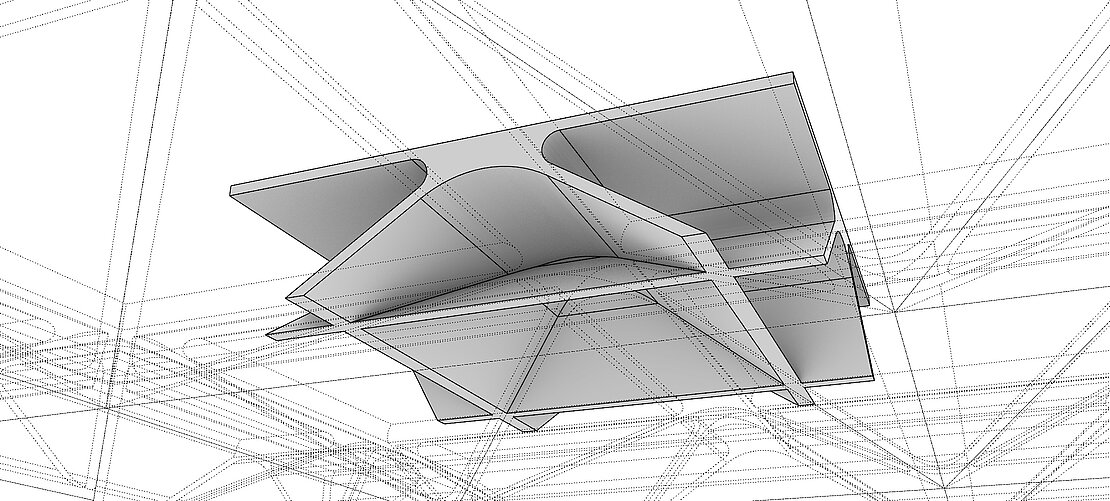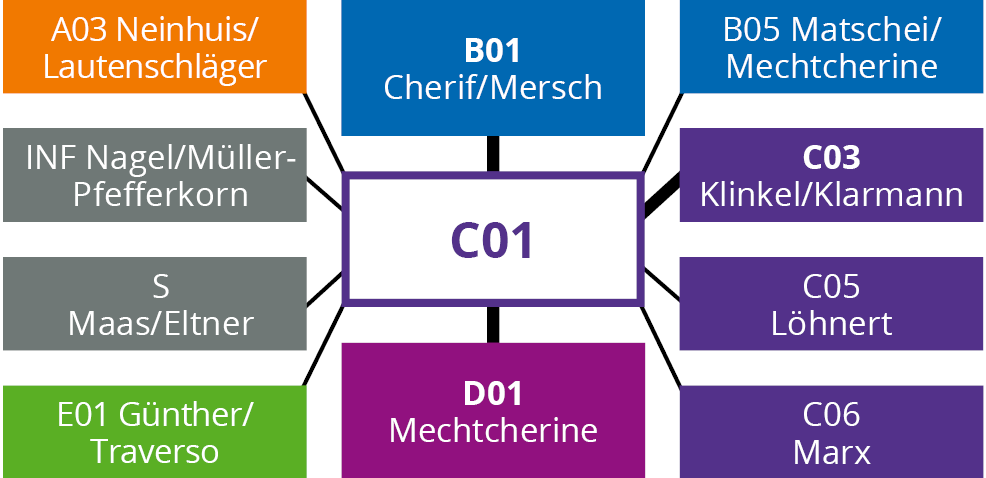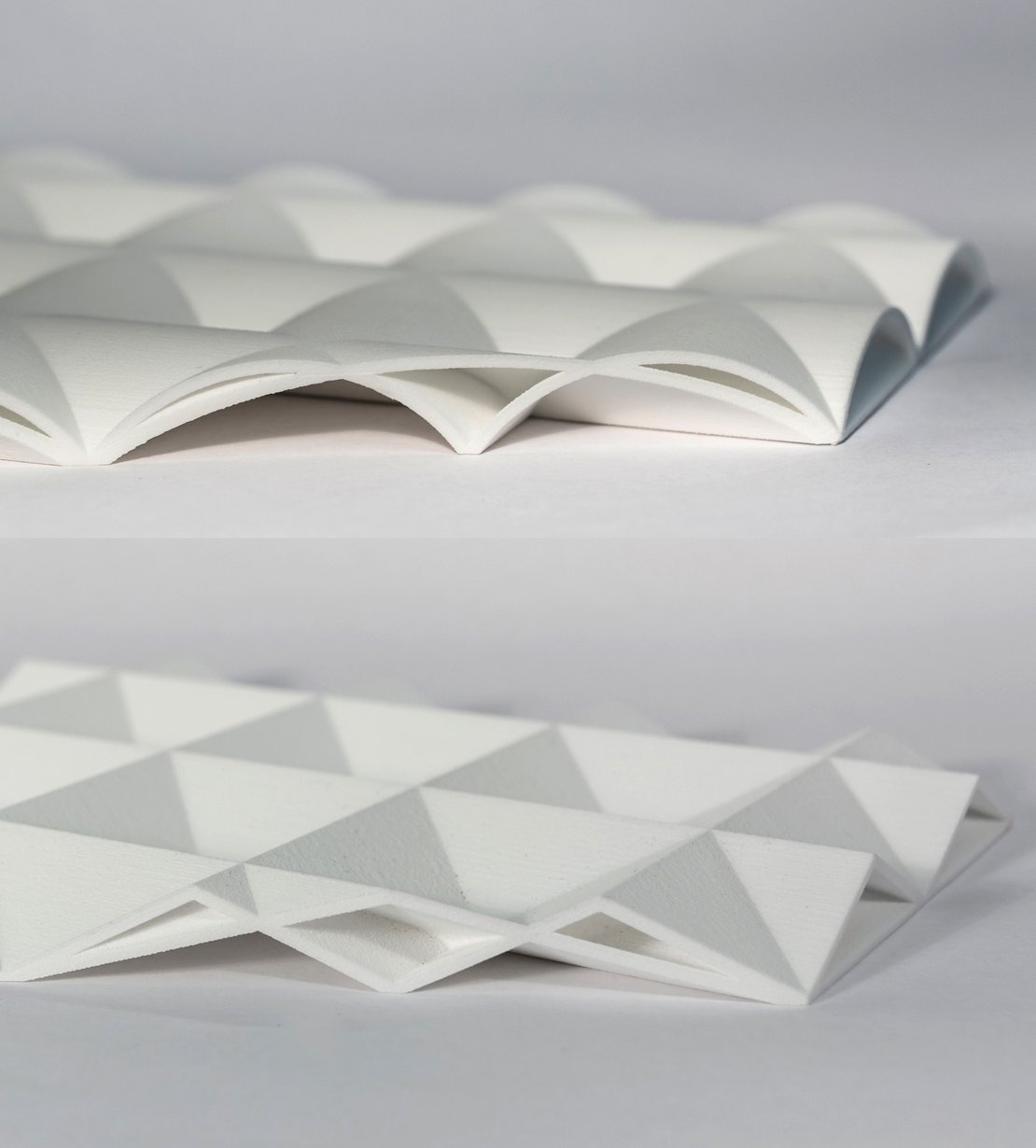Intersecting internal shell-type substructures for enhanced structural efficiency | Funding period 2
The aim of the project is to develop a fundamental methodology for the design of material-efficient carbon-reinforced concrete components on the basis of normal stress-active, shell-shaped structures with different curvatures, with which the usually solid component cross-section is resolved. In funding period 1, this design idea was investigated in its basic features for globally bending load-bearing elements of conventional building construction. In funding period 2, the design space will be fundamentally expanded in order to generalize the approach on this basis. Furthermore, intersections and details, restrictions of different manufacturing methods and the environmental impact will be analyzed in depth.

Scientists

D-01062 Dresden (Germany)
![Dr.-Ing. Viviane Adam [Translate to English:] Viviane Adam](/fileadmin/_processed_/5/a/csm_TP_Z_Adam_Viviane_1a5f1a37ff.jpg)
D-52074 Aachen (Germany)

D-01062 Dresden (Germany)
![M.Sc. Aya Ragab [Translate to English:]](/fileadmin/_processed_/d/e/csm_Aya_Ragab_quadratisch_da7c790032.jpg)
52074 Aachen (Germany)

01062 Dresden (Germany)
Cooperations

Ehemalige | Former involved
Prof. Dr.-Ing. Dr.-Ing. E.h. Manfred Curbach (project leader, TU Dresden, 07/2020 – 06/2024)
Use of Pervading Internal Shell-Type Substructures to Resolve Compact Components
The central aim of project C01 is modify mostly massive concrete components based of internal shell structures and thus to use the shell load-bearing effect in a small scale. In shell construction, which can be found in many variations in nature and technology, complex load-bearing structures can be formed with the most economical use of materials. While natural shell structures serve, for example, as a protective cover for micro-organisms or as light petals to counteract high wind forces, in the building industry it is mainly large areas that are spanned. In comparison to beams and frame structures, where the bending stress due to dead weight increases disproportionately with increasing span width, spatially curved shell structures can handle considerably larger spans with a minimum of material consumption. In the ideal case, the thin-walled structures are subject exclusively to membrane stresses; bending stresses that are unfavourable in terms of statics and material utilisation are avoided. In C01, a method is being developed to resolve components of all kinds on the basis of an internal shell load-bearing effect. Another variant are internal folded structures.

Publikationen | Publications
Mester, L.; Klempt, V.; Wagner, F.; Scheerer, S.; Klarmann, S.; Vakaliuk, I.; Curbach, M.; Maas, H.-G.; Löhnert, S.; Klinkel, S. (2023) A Comparison of Multiscale Methods for the Modelling of Carbon-Reinforced Concrete Structures in: Ilki, A.; Çavunt, D.; Çavunt, Y. S. [eds.] Building for the Future: Durable, Sustainable, Resilient – Proc. of fib Symposium 2023, 05.–07.06.2023 in Istanbul (Turkey), publ. in: Lecture Notes in Civil Engineering 350, Cham: Springer, p. 1418–1427 – DOI: 10.1007/978-3-031-32511-3_145
Vakaliuk, I. (2022) Use of pervading internal shell-type substructures to dissolve compact components in: Curbach, M.; Marx, S.; Mechtcherine, V. [eds.] Beiträge zum 61. Forschungskolloquium mit 9. Jahrestagung des DAfStb, 26./27.09.2022 in Dresden, p. 179–184 – DOI: 10.25368/2022.398
Vakaliuk, I.; Goertzen, T.; Scheerer, S.; Niemeyer, A. C.; Curbach, M. (2022) Initial numerical development of design procedures for TRC bioinspired shells in: Su-duo Xue, S.-d.; Wu, J.-z.; Sun, G.-j. [eds.] Innovation, Sustainability and Legacy – Proceedings of IASS/APCS 2022, 19.–22.09.2022 in Beijing (China), p. 2597–2608.
Vakaliuk, I.; Platen, J.; Klempt, V.; Scheerer, S.; Curbach, M.; Kaliske, M.; Löhnert, S. (2022) Development of load-bearing shell-type TRC structures – initial numerical analysis in: Stokkeland, S.; Braarud, H. C. [eds.] Concrete Innovation for Sustainability – Proc. for the 6th fib International Congress 2022, 12.–16.06.2022 in Oslo (Norway), Oslo: Novus Press, p. 1799–1808.
Vakaliuk, I.; Scheerer, S.; Curbach, M. (2022) Initial laboratory test of load-bearing shell-shaped TRC structures in: Stokkeland, S.; Braarud, H. C. [eds.] Concrete Innovation for Sustainability – Proc. for the 6th fib International Congress 2022, 12.–16.06.2022 in Oslo (Norway), Oslo: Novus Press, p. 675-684.
Vakaliuk, I.; Scheerer, S.; Curbach, M. (2024) Leichte Deckenelemente aus Carbonbeton in: Beton- und Stahlbetonbau, online first: 18.09.2024 – https://doi.org/10.1002/best.202400060
Vakaliuk, I.; Scheerer, S.; Curbach, M. (2024) Numerical Analysis of Textile Reinforced Concrete Shells: Force Interaction and Failure Types in: CivilEng 5, issue 1/Special Issue Feature Papers in CivilEng, p. 224–246 – DOI: https://doi.org/10.3390/civileng5010012 (first publ. 2023 in: Preprints, 2023120700 – DOI: https://doi.org/10.20944/preprints202312.0700.v1, modified)
Vakaliuk, I.; Scheerer, S.; Curbach, M. (2024) The Numerical Analysis of Textile Reinforced Concrete Shells: Basic Principles in: Appl. Sci. 14, issue 5, 2140 – DOI: https://doi.org/10.3390/app14052140 (first publ. 2023 in: Preprints, 2023120705 – DOI: https://doi.org/10.20944/preprints202312.0705.v1, modified)
Vakaliuk, I.; Scheerer, S.; Curbach, M. (2023) Vacuum-Assisted Die Casting Method for the Production of Filigree Textile-Reinforced Concrete Structures in: Buildings 13, issue 10 (Spec. Issue Research on the Performance of Non-metallic Reinforced Concrete), 2641 – DOI: 10.3390/buildings13102641
Vakaliuk, I.; Scheerer, S.; Liebold, F.; Wagner, F.; Kruppa, H.; Vollpracht, A.; Curbach, M. (2024) Properties of the High-Performance Matrix of TRC Elements Cast Under Vacuum Conditions in: Mechtcherine, V.; Signorini, C.; Junger, D. [eds.]: Transforming Construction: Advances in Fiber Reinforced Concrete – Proc. of XI RILEM-fib Int. Symp. on Fiber Reinforced Concrete (BEFIB 2024), 15.–18.09.2024 in Dresden, publ. in RILEM Bookseries, Vol. 54, Cham: Springer Nature Switzerland, p. 786–793 – https://doi.org/10.1007/978-3-031-70145-0_93
Wiesenhuetter, S.; Goertzen, T.; Vakaliuk, I.; Curbach, M.; Scheerer, S.; Niemeyer, A. C.; Noennig, J. R. (2023) Triply Periodic Minimal Surfaces – A Novel Design Approach for Lightweight CRC Structures in: Ilki, A.; Çavunt, D.; Çavunt, Y. S. [eds.] Building for the Future: Durable, Sustainable, Resilient – Proc. of fib Symposium 2023, 05.–07.06.2023 in Istanbul (Turkey), publ. in: Lecture Notes in Civil Engineering, Vol 350, Cham: Springer, p. 1449–1458 – DOI: 10.1007/978-3-031-32511-3_148
Zdanowicz, K.; Vakaliuk, I.; Beckmann, B.; Marx, S. (2022) Two-dimensional strain measurements of chemically prestressed textile reinforced concrete slabs with distributed fibre optic sensors in: Stokkeland, S.; Braarud, H. C. [eds.] Concrete Innovation for Sustainability – Proc. for the 6th fib International Congress 2022, 12.–16.06.2022 in Oslo (Norway), Oslo: Novus Press, p. 666–674.
Vorträge | Oral presentations
Vakaliuk, I. (2022) Generative design in textile reinforced concrete structures oral presentation at: AdvanceAEC Autumn School 2022, 11.10.2022 in Stuttgart
Studentische Arbeiten | Student's works
Abimbola, O. D. (2021) Conceptual development of the carbon reinforcement unconstrained laying algorithm [Projektarbeit | project work]
Sezallari, K. (2021) Development of a multifunctional interface between ConFEM software and Grasshopper 3D environment [Projektarbeit | project work]
Abimbola, O. D. (2022) Development of the programming GH tool for the production of thin-walled TRC structures using methods of 3D concrete printing [Masterarbeit | Master’s thesis] (mit | with D01)
Byron, J. (2022) Precast Modular Bridge Design made of Ultra High- Performance Concrete [Projektarbeit | project work]
Sezallari, K. (2022): Form follows environment – Flexible Glass Façade optimized with 3D printing and Grasshopper form optimization [Masterarbeit | Master’s thesis]
Marcillo Delgado, E. (2023) Influence of the permanent formwork elements on the structural performance of the cellular TRC structures [Masterarbeit | Master’s thesis]
Chakkarathodi, A. K. (2023) Development of the workflow for the analysis of the TRC structure’s geometry using methods of 3D scanning [Masterarbeit | Master’s thesis] (mit | with S)




